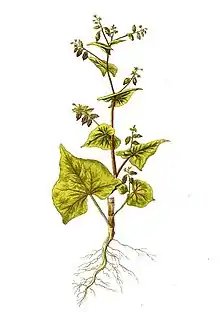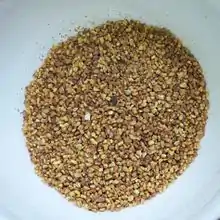Fagopyrum tataricum
Fagopyrum tataricum, also known as Tartary buckwheat,[2] green buckwheat,[3] ku qiao,[3] Tatar buckwheat, or bitter buckwheat,[4] is a domesticated food plant in the genus Fagopyrum in the family Polygonaceae. With another species in the same genus, common buckwheat, it is often counted as a cereal, but unlike the true cereals the buckwheats are not members of the grass family. Thus, they are not related to true wheat. Tartary buckwheat is more bitter and contains more rutin than common buckwheat. It also contains quercitrin.[5]
| Tartary buckwheat | |
|---|---|
 | |
| Scientific classification | |
| Kingdom: | Plantae |
| Clade: | Tracheophytes |
| Clade: | Angiosperms |
| Clade: | Eudicots |
| Order: | Caryophyllales |
| Family: | Polygonaceae |
| Genus: | Fagopyrum |
| Species: | F. tataricum |
| Binomial name | |
| Fagopyrum tataricum | |
| Synonyms[1] | |
| |
Tatary buckwheat was domesticated in east Asia and is also cultivated in Europe and North America.[6] While it is an unfamiliar food in the West, it is common in the Himalayan region today, as well as other regions in Southwest China such as Sichuan province.

The plant has been cultivated in many parts of the world; however, when found among other crops it is considered a weed.[7][8]

Chemistry
Fagopyrum tataricum contains aromatic substances. The most important difference when compared to the aroma of Fagopyrum esculentum is the absence of salicylaldehyde and presence of naphthalene.[9]
References
- "The Plant List: A Working Checklist of all Plant Species".
- "Fagopyrum tataricum". Natural Resources Conservation Service PLANTS Database. USDA. Retrieved 19 January 2016.
- "Fagopyrum tataricum". Germplasm Resources Information Network (GRIN). Agricultural Research Service (ARS), United States Department of Agriculture (USDA). Retrieved 21 December 2017.
- Report of a Network Coordinating Group on Minor Crops. Bioversity International. pp. 65–66. GGKEY:J811QDJNL4H.
- Fabjan, Nina; Rode, Janko; Košir, Iztok Jože; Wang, Zhuanhua; Zhang, Zheng; Kreft, Ivan (2003). "Tartary Buckwheat (Fagopyrum tataricum Gaertn.) as a Source of Dietary Rutin and Quercitrin". Journal of Agricultural and Food Chemistry. 51 (22): 6452–5. doi:10.1021/jf034543e. PMID 14558761.
- Li Anjen and Suk-pyo Hong (2004). "Fagopyrum tataricum". Flora of China. 5.
- "Interactive Agricultural Ecology Atlas of Russia and Neighbouring Countries". Retrieved 16 December 2014.
- Sharma, M.P. (1986). "The Biology Of Canadian Weeds: 74. Fagopyrum tataricum (L.) Gaertn". Canadian Journal of Plant Science. 66 (2): 381–393. doi:10.4141/cjps86-052.
- Janeš, Damjan; Prosen, Helena; Kreft, Samo (2012). "Identification and Quantification of Aroma Compounds of Tartary Buckwheat (Fagopyrum tataricum Gaertn.) and Some of Its Milling Fractions". Journal of Food Science. 77 (7): C746–51. doi:10.1111/j.1750-3841.2012.02778.x. PMID 22757696.
External links
 Media related to Fagopyrum tataricum at Wikimedia Commons
Media related to Fagopyrum tataricum at Wikimedia Commons